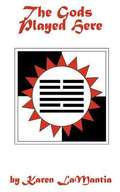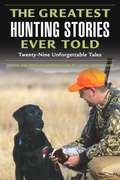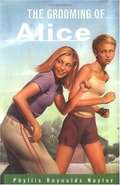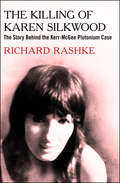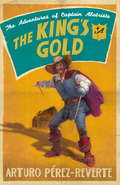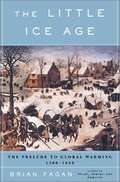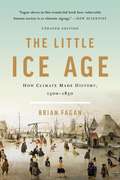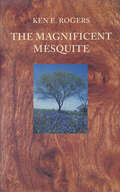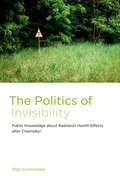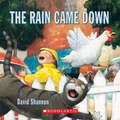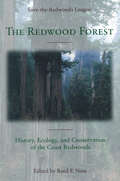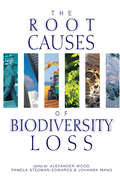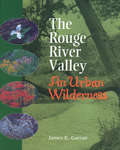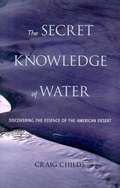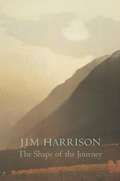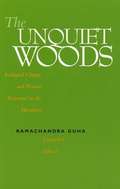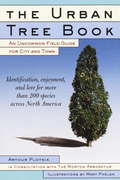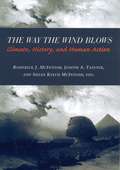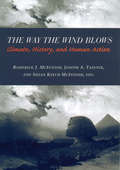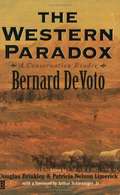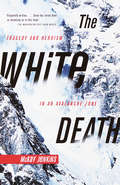- Table View
- List View
The Gods Played Here and the Story of the Seven Beans
by Karen LamantiaA humorous adventure story about humanity's response to saving the planet from our own environmental devastation.
The Greatest Hunting Stories Ever Told: Twenty-Nine Unforgettable Tales
by Lamar UnderwoodHunting is a serious business-but it's also about camaraderie, achievements and failures, seeing new places, and revisiting cherished ones. The true stories here feature a variety of game, in locations that range from high Yukon Territory mountain peaks to lowland swamps off of Mobile Bay, Alabama. This is an indispensable volume for all lovers and students of the natural world. If your definition of home includes fields and marshes, creeks and river bottoms, plains and mountains, consider this required reading.
The Green Pharmacy Herbal Handbook
by James O. DukeIn this handy companion to his best-selling book The Green Pharmacy, leading herbal authority James A. Duke, Ph.D.., delivers the lowdown on virtually every healing herb available in today's marketplace: its description and history, therapeutic uses, medicinal properties, prescription counterparts, dosage options, safety and effectiveness rating, and precautions. Dr. Duke's inimitable folksy tone and friendly manner shine throughout The Green Pharmacy Herbal Handbook, making it as entertaining to read as it is practical. The most thorough,and comprehensive herb reference of its kind, the handbook was culled from the thousands of entries in Dr. Duke's database of the world's medicinal plants. The database, which he began during his career as a top botanist with the USDA, is a lifelong project for Dr. Duke and has become a major reference resource for herbalists worldwide.
The Grooming of Alice (Alice McKinley #12)
by Phyllis Reynolds NaylorDuring the summer between eighth and ninth grades. Alice and her friends Pamela and Elizabeth decide to improve themselves through exercise.
The Killing of Karen Silkwood: The Story Behind the Kerr-McGee Plutonium Case
by Richard RashkeOn November 13, 1974, Karen Silkwood was driving on a deserted Oklahoma highway when her car crashed into a cement wall and she was killed. On the seat next to her were doctored quality-control negatives showing that her employer, Kerr-McGee, was manufacturing defective fuel rods filled with plutonium. She had recently discovered that more than forty pounds of plutonium were missing from the Kerr-McGee plant. Forty years later, her death is still steeped in mystery. Did she fall asleep before the accident, or did someone force her off the road? And what happened to the missing plutonium? The Killing of Karen Silkwood meticulously lays out the facts and encourages the readers to decide. Updated with the author's chilling new introduction that discusses the similarities with Edward Snowden's recent revelations, Silkwood's story is as relevant today as it was forty years ago. For this updated edition, the author has added the latest information as to what happened to the various people involved in the Silkwood case and news of the lasting effects of this underreported piece of the history of the antinuclear movement.
The King's Gold (The Adventures of Captain Alatriste)
by Arturo Perez-ReverteIn this fourth instalment, Captain Alatriste becomes involved in a mission to save the King of Spain's gold... Swashbuckling adventure and high octane action.The year is 1626, and a battle-weary Captain Alatriste and his companions sail home from the on-going war in Flanders. He returns to a Spain that is rotten to the core, as gold from the Americas floods into the port of Seville, brought by the country's infamous treasure fleet.As various factions within the Court vie for supremacy, certain interests are creaming off undeclared profits from the galleons' cargo, thus depriving the royal treasury of its lifeblood. Indeed some of the booty is finding its way into the hands of the same rebel provinces Spain is fighting to suppress.The King and his most trusted advisor, the Count-Duke Olivares, have become aware of one such plot and have decided to teach the perpetrator a lesson. Once more, they must call upon Captain Alatriste's blade in a dangerous adventure that will bring the captain face to face with his nemesis, and with a ruthless man who has designs on the throne...
The Little Ice Age
by Brian M. FaganThe Little Ice Age, the most significant climate event of the last millennium, was sandwiched between two warm spells-- the Medieval Warm Period, which lasted from about 900 to 1300 AD, and the present global warming, which began in about 1850. Although climatologists long suspected the broad outlines of these periods, only within the past decade have they developed an accurate picture of climate conditions in historical times. They can now determine yearly average temperatures and rainfall, the times and magnitude of volcanic eruptions, and even how brightly the sun shone centuries ago. This book focuses on the weather, farming and the fishing and exploring of the north Atlantic.
The Little Ice Age: How Climate Made History 1300-1850
by Brian FaganOnly in the last decade have climatologists developed an accurate picture of yearly climate conditions in historical times. This development confirmed a long-standing suspicion: that the world endured a 500-year cold snap-The Little Ice Age-that lasted roughly from A.D. 1300 until 1850. The Little Ice Age tells the story of the turbulent, unpredictable and often very cold years of modern European history, how climate altered historical events, and what they mean in the context of today's global warming. With its basis in cutting-edge science, The Little Ice Age offers a new perspective on familiar events. Renowned archaeologist Brian Fagan shows how the increasing cold affected Norse exploration; how changing sea temperatures caused English and Basque fishermen to follow vast shoals of cod all the way to the New World; how a generations-long subsistence crisis in France contributed to social disintegration and ultimately revolution; and how English efforts to improve farm productivity in the face of a deteriorating climate helped pave the way for the Industrial Revolution and hence for global warming. This is a fascinating, original book for anyone interested in history, climate, or the new subject of how they interact.
The Lying StonesThe lying stones of Marrakech: Penultimate Reflections in Natural History
by Stephen Jay GouldEssays culled from Gould's monthly column "The View of Life", in Natural History magazine that he wrote for 27 years.
The Magnificent Mesquite (Corrie Herring Hooks Series)
by Ken E. RogersA reliable source of food and shelter even in the severest droughts, the mesquite tree sustained American Indians in the Southwest for centuries. Today, mesquite is popular for barbecuing, woodworking, furniture making, flooring, sculpture, jewelry, and food products ranging from honey to jelly and syrup. Even ranchers, who once fought to eradicate mesquite, have come to value its multiple uses on well-managed rangeland. In this book written especially for a general readership, one of the world's leading authorities on mesquite presents a wealth of information about its natural history and commercial, agricultural, and woodworking uses. Ken Rogers describes the life cycle, species, and wide distribution of the mesquite, which is native or naturalized not only in the Southwest and Mexico, but also in India, Africa, Australia, South America, and Hawaii. He discusses the many consumer and woodworker uses of mesquite at length-even giving instructions for laying a mesquite wood floor and making mesquite bean jelly. He also looks into the ways that people are using mesquite in nature, from rangeland management in the Southwest to desertification prevention in arid countries.
The Magnificent Mesquite (Corrie Herring Hooks Series)
by Ken E. RogersA reliable source of food and shelter even in the severest droughts, the mesquite tree sustained American Indians in the Southwest for centuries. Today, mesquite is popular for barbecuing, woodworking, furniture making, flooring, sculpture, jewelry, and food products ranging from honey to jelly and syrup. Even ranchers, who once fought to eradicate mesquite, have come to value its multiple uses on well-managed rangeland. In this book written especially for a general readership, one of the world' leading authorities on mesquite presents a wealth of information about its natural history and commercial, agricultural, and woodworking uses. Ken Rogers describes the life cycle, species, and wide distribution of the mesquite, which is native or naturalized not only in the Southwest and Mexico, but also in India, Africa, Australia, South America, and Hawaii. He discusses the many consumer and woodworker uses of mesquite at length-even giving instructions for laying a mesquite wood floor and making mesquite bean jelly. He also looks into the ways that people are using mesquite in nature, from rangeland management in the Southwest to desertification prevention in arid countries.
The Politics of Invisibility
by Olga KuchinskayaBefore Fukushima, the most notorious large-scale nuclear accident the world had seenwas Chernobyl in 1986. The fallout from Chernobyl covered vast areas in the Northern Hemisphere,especially in Europe. Belarus, at the time a Soviet republic, suffered heavily: nearly a quarter ofits territory was covered with long-lasting radionuclides. Yet the damage from the massive falloutwas largely imperceptible; contaminated communities looked exactly like noncontaminated ones. Itcould be known only through constructed representations of it. In The Politics ofInvisibility, Olga Kuchinskaya explores how we know what we know about Chernobyl,describing how the consequences of a nuclear accident were made invisible. Her analysis shedsvaluable light on how we deal with other modern hazards -- toxins or global warming -- that arelargely imperceptible to the human senses. Kuchinskaya describes the production ofinvisibility of Chernobyl's consequences in Belarus -- practices that limit public attention toradiation and make its health effects impossible to observe. Just as mitigating radiologicalcontamination requires infrastructural solutions, she argues, the production and propagation ofinvisibility also involves infrastructural efforts, from redefining the scope and nature of theaccident's consequences to reshaping research and protection practices. Kuchinskaya finds vast fluctuations in recognition, tracing varyingly successfulefforts to conceal or reveal Chernobyl's consequences at different levels -- among affectedpopulations, scientists, government, media, and international organizations. The production ofinvisibility, she argues, is a function of power relations.
The Rain Came Down
by David ShannonCaldecott Honor artist David Shannon captures the chaos that follows an unexpected downpour in this engaging story.Once upon a sunny day, the sky clouded over, and the rain came down. The chickens squawked, the dog barked, the baby cried, the traffic snarled, the groceries fell, the people bickered, and still, the rain came down.In pictures full of wit and good-natured humor, Caldecott Honor artist David Shannon captures the chaos that follows an unexpected downpour.Rain or shine, here is an engaging story that will brighten the day of any reader.
The Redwood Forest: History, Ecology, and Conservation of the Coast Redwoods
by Reed F. Noss Save-the-Redwoods LeagueEvidence is mounting that redwood forests, like many other ecosystems, cannot survive as small, isolated fragments in human-altered landscapes. Such fragments lose their diversity over time and, in the case of redwoods, may even lose the ability to grow new, giant trees.The Redwood Forest, written in support of Save-the-Redwood League's master plan, provides scientific guidance for saving the redwood forest by bringing together in a single volume the latest insights from conservation biology along with new information from data-gathering techniques such as GIS and remote sensing. It presents the most current findings on the geologic and cultural history, natural history, ecology, management, and conservation of the flora and fauna of the redwood ecosystem. Leading experts offer a comprehensive account of the redwoods ecosystem, with specific chapters examining the history of the redwood lineage; terrestrial flora and fauna, communities, and ecosystems; aquatic ecosystems; landscape-scale conservation planning; and management alternatives relating to forestry, restoration, and recreation; among other topics.The Redwood Forest offers a case study for ecosystem-level conservation and gives conservation organizations the information, technical tools, and broad perspective they need to evaluate redwood sites and landscapes for conservation. It contains the latest information from groundbreaking research on such topics as redwood canopy communities, the role of fog in sustaining redwood forests, and the function of redwood burls. It also presents sobering lessons from current research on the effects of forestry activities on the sensitive faunas of redwood forests and streams. The key to perpetuating the redwood forest is understanding how it functions; this book represents an important step in establishing such an understanding.
The Root Causes of Biodiversity Loss
by Alexander Wood Pamela Stedman-Edwards Johanna MangThe world is losing species and biodiversity at an unprecedented rate. The causes go deep and the losses are driven by a complex array of social, economic, political and biological factors at different levels. Immediate causes such as over-harvesting, pollution and habitat change have been well studied, but the socioeconomic factors driving people to degrade their environment are less well understood. This book examines the underlying causes. It provides analyses of a range of case studies from Brazil, Cameroon, China, Danube River Basin, India, Mexico, Pakistan, Philippines, Tanzania and Vietnam, and integrates them into a new and interdisciplinary framework for understanding what is happening. From these results, the editors are able to derive policy conclusions and recommendations for operational and institutional approaches to address the root causes and reverse the current trends. It makes a contribution to the understanding of all those - from ecologists and conservationists to economists and policy makers - working on one of the major challenges we face.
The Rouge River Valley: An Urban Wilderness
by James E. GarrattThe Rouge River Valley, eleven thousand acres of urban wilderness, is a unique, yet very fragile and transient natural phenomenon existing within the confines of a major North American city, Toronto. Fed by the Oak Ridges Moraine, the Rouge river system has, over generations of time, cut its identity into the land, shaping the habitat for a multitude of lifeforms, many of which are now either threatened or gone. Author James E. Garratt, a seasoned environmentalist, shares two decades of personal observation and ecological study to reveal the richness and flow of seasonal changes in this exceptional urban park. This "portrait" of a year in the Rouge Valley explores not only the diversity of life in its natural habitat but also the impact of urban sprawl and the inevitable conflict with development. Is it possible to be a true naturalist "grounded" in a modern city? The words of Ian McHarg, an urban planner, hold true: "We need nature as much in the city as in the country."
The Secret Knowledge of Water: Discovering the Essence of the American Desert
by Craig ChildsA naturalist and explorer finds water holes, storms, floods and fascinating life forms in the Arizona desert and Grand Canyon.
The Shape of the Journey
by Jim HarrisonHere is the definitive collection of poetry from one of America's best-loved writers-now available in paperback. With the publication of this book, eight volumes of poetry were brought back into print, including the early nature-based lyrics of Plain Song, the explosive Outlyer & Ghazals, and the startling "correspondence" with a dead Russian poet in Letters to Yesenin. Also included is an introduction by Harrison, several previously uncollected poems, and "Geo-Bestiary," a 34-part paean to earthly passions. The Shape of the Journey confirms Jim Harrison's place among the most brilliant and essential poets writing today."Behind the words one always feels the presence of a passionate, exuberant man who is at the same time possessed of a quick, subtle intelligence and a deeply questioning attitude toward life. Harrison writes so winningly that one is simply content to be in the presence of a writer this vital, this large-spirited."--The New York Times Book Review"(An) untrammelled renegade genius... here's a poet talking to you instead of around himself, while doing absolutely brilliant and outrageous things with language."-Publishers Weekly"Readers can wander the woods of this collection for a lifetime and still be amazed at what they find."-Booklist (starred review.)When first published, this book immediately became one of Copper Canyon Press's all-time bestsellers. It was featured on Garrison Keillor's Writer's Almanac, became a finalist for the Los Angeles Times Book Prize, and was selected as one of the "Top-Ten Books of 1998" by Booklist.Jim Harrison is the author of twenty books, including Legends of the Fall and The Road Home. He has also written numerous screenplays and served as the food columnist for Esquire magazine. He lives in Michigan and Arizona.Dead DeerAmid pale green milkweed, wild clover, a rotted deer curled, shaglike, after a winter so cold the trees split open. I think she couldn't keep up with the others (they had no place to go) and her food, frozen grass and twigs,
The Unquiet Woods: Ecological Change and Peasant Resistance in the Himalaya
by Ramachandra GuhaThe Unquiet Woods, Ramachandra Guha's path breaking study of peasant movements against commercial forestry, offers a new epilogue that brings the story of Himalayan social protest up-to-date, reflecting the Chipko movement's continuing influence in the wider world.
The Urban Tree Book: An Uncommon Field Guide for City and Town
by Arthur PlotnikOpenThe Urban Tree Bookand discover the joys of forest trekking--right in your city or town. This first-of-a-kind field guide introduces readers to the trees on their block, in neighborhood parks, and throughout the urban landscape. Unlike traditional tree guides with dizzying numbers of woodland species, The Urban Tree Book explores nature in the city, describing some 200 tree types likely to be found on North America's streets and surrounding spaces, including suburban settings. With telling descriptions and precise botanical detail, this unique guide not only identifies trees but brings them to life through history, lore, anecdotes, up-to-date facts, and hundreds of fascinating characteristics. More than 175 graceful illustrations capture the charm of trees in urban settings and depict leaf, flower, fruit, and bark features for identification and appreciation. The Urban Tree Bookwill inform even the most knowledgeable plant person and delight urbanites who simply enjoy strolling beneath the shade of welcoming trees. An engaging excursion into the "urban forest," this complete guide to city trees will both entertain and enlighten nature lovers, urban hikers, gardeners, and everyone curious about their environment. Includes a tree planting-and-care section, tree primer, and exploration guide Is backed by the expertise of the renowned Morton Arboretum Incorporates new "urban forestry" perspectives Covers urban trees across the continent Lists key organizations and institutions for tree lovers Selects the best tree sites on the Internet Updates many guides by 20 years
The View from Bald Hill: Thirty Years in an Arizona Grassland
by Carl E. Bock Jane H. BockIn 1540 Francisco Vasquez de Coronado introduced the first domestic livestock to the American Southwest. Over the subsequent four centuries, cattle, horses, and sheep have created a massive ecological experiment on these arid grasslands, changing them in ways we can never know with certainty. The Appleton-Whittell Research Ranch in the high desert of southeastern Arizona is an 8,000-acre sanctuary where grazing has been banned since 1968. In this spirited account of thirty years of research at the ranch, Carl and Jane Bock summarize the results of their fieldwork, which was aimed at understanding the dynamics of grasslands in the absence of livestock. The View from Bald Hill provides an intimate look at the natural history of this unique site and illuminates many issues pertaining to the protection and restoration of our nation's grasslands.
The Way the Wind Blows: Climate, History, and Human Action
by Joseph A. Tainter Susan Keech Mcintosh Roderick J. McintoshScientists and policymakers are beginning to understand in ever-increasing detail that environmental problems cannot be understood solely through the biophysical sciences. Environmental issues are fundamentally human issues and must be set in the context of social, political, cultural, and economic knowledge. The need both to understand how human beings in the past responded to climatic and other environmental changes and to synthesize the implications of these historical patterns for present-day sustainability spurred a conference of the world's leading scholars on the topic. The Way the Wind Blows is the rich result of that conference. Articles discuss the dynamics of climate, human perceptions of and responses to the environment, and issues of sustainability and resiliency. These themes are illustrated through discussions of human societies around the world and throughout history.
The Way the Wind Blows: Climate, History, and Human Action
by Joseph A. Tainter Susan Keech Mcintosh Roderick J. McintoshScientists and policymakers are beginning to understand in ever-increasing detail that environmental problems cannot be understood solely through the biophysical sciences. Environmental issues are fundamentally human issues and must be set in the context of social, political, cultural, and economic knowledge. The need both to understand how human beings in the past responded to climatic and other environmental changes and to synthesize the implications of these historical patterns for present-day sustainability spurred a conference of the world's leading scholars on the topic. The Way the Wind Blows is the rich result of that conference. Articles discuss the dynamics of climate, human perceptions of and responses to the environment, and issues of sustainability and resiliency. These themes are illustrated through discussions of human societies around the world and throughout history.
The Western Paradox: A Conservation Reader
by Arthur M. Schlesinger Bernard Devoto Douglas Brinkley Patricia NelsonThis book is the fascinating record of DeVoto's crusade to save the West from itself.
The White Death: Tragedy and Heroism in an Avalanche Zone
by Mckay JenkinsIn 1969, five young men from Montana set out to accomplish what no one had before: to scale the sheer north face of Mt. Cleveland, Glacier National Park's tallest mountain, in winter. Two days later tragedy struck: they were buried in an avalanche so deep that their bodies would not be discovered until the following June. The White Death is the riveting account of that fated climb and of the breathtakingly heroic rescue attempt that ensued. In the spirit of Peter Matthiessen and John McPhee, McKay Jenkins interweaves a harrowing narrative with an astonishing expanse of relevant knowledge ranging from the history of mountain climbing to the science of snow. Evocative and moving, this fascinating book is a humbling account of man at his most intrepid and nature at its most indomitable.
